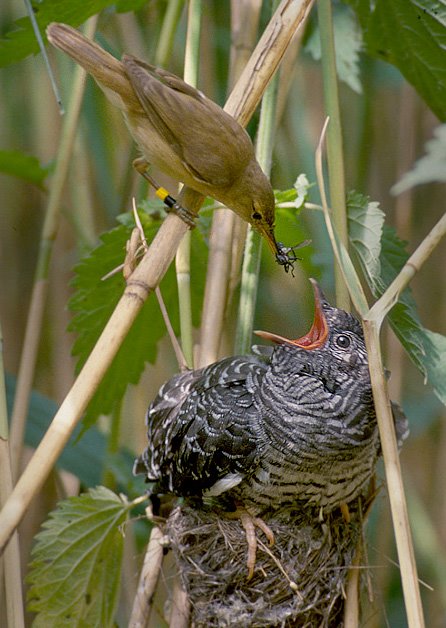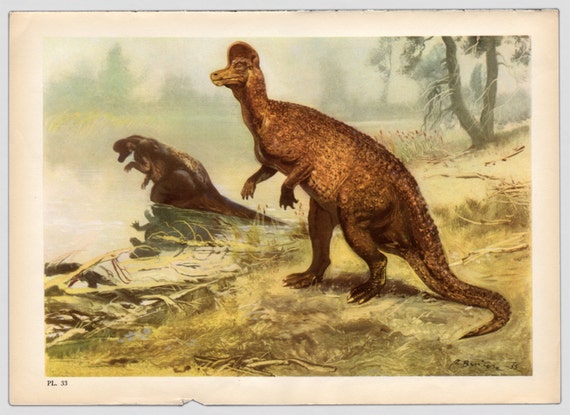 |
| The Common Cuckoo (Cuculus canorus) might be known for its iconic call, but its true hallmark is the tactics it uses to shirk parenting duties |
During the European spring and summer, the cuckoo's familiar call echoes through the air.
'CUCK-oo' 'CUCK-oo' 'CUCK-oo'
Like many birds, common cuckoos journey from their southern wintering grounds to exploit the bounty that comes with warm weather further north. And like many birds, spring heralds that time of year when 'the birds and the bees' are in full flight and buzz. But while caring parents like wrens, robins, and common redstarts busily build their nests, female cuckoos sit and wait.
And wait.
And wait.
All the meanwhile stuffing themselves on the myriad bugs. Until finally, a nest is complete -- someone else's nest, that is.
A small Eurasian reed warbler that also made a long northern migration set up camp in the marsh reeds. Strung among a handful of reeds sits its conical nest with three or four cream-colored eggs with brown splotches. As she sits, diligently warming her eggs, a sudden call pierces the air.
'kwik-kwik-kwik-kwik-kwik...'
The warbler lifts her head, alarmed by the threat.
'kwik-kwik-kwik-kwik-kwik...' the call repeats
A Eurasian sparrowhawk -- a predator and close by.
She hurriedly scans the area. The call picks up again.
'kwik-kwik-kwik-kwik-kwik...'
Not wanting to take any chances for her own life, the warbler hops out of her nest, heading away to other reeds where she can scan the sky better. While away, though, a female cuckoo swoops right near the nest. Forcing herself into the nest, the cuckoo settles for a minute. At twice the size of the warbler's nest, the cuckoo looks like an adult person stuck in a toddler swing. She lays an egg -- cream-colored with brown splotches, just like the warblers. And just before vacating the nest, she lets out a final call.
'kwik-kwik-kwik-kwik-kwik...'
And takes off.
Clever Cuckoos
 |
| A reed warbler feeds a cuckoo chick -- the warbler's chicks having died because the cuckoo chick rolled them out of the nest before they hatched |
This is because cuckoos are masters of imitation, and for some, the degree of imitation reaches incredible proportions -- eggs that look identical to their host's; feathers that nearly match those of common predators; and now, a recent study published last week in Nature Ecology and Evolution showed that common cuckoos even imitate the sounds or chuckles of hawks to ward off would be vigilant parents.
"[F]emale [cuckoo] chuckles play an important role in a suite of specialized female traits associated with a brood-parasitic lifestyle," wrote authors Jenny York, an associate research professor at the University of Cambridge, and Nick Davies, a professor of behavioral ecology also at the University of Cambridge. Those traits include stealth skills while sneaking up on a host nest, feather plumage that looks much like a hawk's, and incredible spatial memory skills to recall where their victim's nest is. These chuckles, though, unify their toolbox of deceptive skills because it misdirects the host's attention away from the nest.
"Female cuckoos rarely call," wrote the authors, a point that differs diametrically from male cuckoos that announce their position with the famous 'CUCK-oo' call. But oddly enough, the time when female cuckoos do call is while monitoring a host's nest and immediately after parasitizing the nest, both of which open a slew of possible problems for the cuckoo.
"Previous studies have shown that hosts of the common cuckoo...defend against parasitism by mobbing the adult cuckoos," noted the authors, "and by rejecting eggs that differ from their own." Cuckoos compensate for some of this through egg mimicry and stealthy operation. But announcing their position just as they plan to swoop in on the nest still seems odd.
The clue that tipped York and Davies came from the similarity between a cuckoo's chuckle and a Eurasian sparrowhawk's call, the latter a common predator of the area.
"[The cuckoo's] chuckle call -- a rapidly repeated 'kwik-kwik-kwik-...' -- is similar in fundamental frequency and rate to the 'kii-kii-kii...' of Accipiter hawks..." On top of it, common cuckoo's can look a lot like the sparrowhawk.
York and Davies put their idea to the test by playing multiple bird sounds through speakers placed near reed warbler nests. Some bird sounds were from harmless neighbors, like the coos of collared doves and 'cuck-oo' of male cuckoos, whereas the others came from potential threats, like the Eurasian sparrowhawk call and the female cuckoo's chuckle.
They found that reed warblers increased their vigilance and scanning when they heard either the sparrowhawk call or cuckoo's chuckle but remained imperturbed by the other calls. This was true even when they tested calls on great tits and blue tits, birds in the area not parasitized by cuckoos.
But even if cuckoos distract the warblers, that doesn't mean the cuckoo egg laid in the nest will be accepted. So to really nail how effective this tactic is, York and Davies manipulated the nests with dummy eggs, painting a warbler's egg brown so it looked like the nest had been parasitized by a cuckoo and then stuck a wooden cuckoo next to the nest with a speaker behind it.
Though warblers invariably attacked the models, it turned out that the probability of warblers accepting the "parasitic" egg after a female cuckoo chuckle was nearly 80 percent. This seems to make sense to York and Davies.
"If hosts respond to a cuckoo call as if it were a hawk, they are less likely to reject a cuckoo egg, but if they fail to respond to a hawk call they may lose their life."
The trade-off for the warbler is clear: Protect your young or protect your life. It's a stunning discovery that shows how female cuckoos increase their chances of success and adds yet one more skill to the cuckoo's ever-growing resume of manipulation and imitation.
"[T]he female cuckoo might have 'the last laugh' in this particular battle between host defense and parasite trickery."
 |
Various
cuckoo species have evolved astounding imitations, such as egg colors that
almost perfectly match their host's
(Source: http://fsc.fernbank.edu/Birding/parasitism.htm) |
"Female cuckoos rarely call," wrote the authors, a point that differs diametrically from male cuckoos that announce their position with the famous 'CUCK-oo' call. But oddly enough, the time when female cuckoos do call is while monitoring a host's nest and immediately after parasitizing the nest, both of which open a slew of possible problems for the cuckoo.
"Previous studies have shown that hosts of the common cuckoo...defend against parasitism by mobbing the adult cuckoos," noted the authors, "and by rejecting eggs that differ from their own." Cuckoos compensate for some of this through egg mimicry and stealthy operation. But announcing their position just as they plan to swoop in on the nest still seems odd.
The clue that tipped York and Davies came from the similarity between a cuckoo's chuckle and a Eurasian sparrowhawk's call, the latter a common predator of the area.
"[The cuckoo's] chuckle call -- a rapidly repeated 'kwik-kwik-kwik-...' -- is similar in fundamental frequency and rate to the 'kii-kii-kii...' of Accipiter hawks..." On top of it, common cuckoo's can look a lot like the sparrowhawk.
York and Davies put their idea to the test by playing multiple bird sounds through speakers placed near reed warbler nests. Some bird sounds were from harmless neighbors, like the coos of collared doves and 'cuck-oo' of male cuckoos, whereas the others came from potential threats, like the Eurasian sparrowhawk call and the female cuckoo's chuckle.
They found that reed warblers increased their vigilance and scanning when they heard either the sparrowhawk call or cuckoo's chuckle but remained imperturbed by the other calls. This was true even when they tested calls on great tits and blue tits, birds in the area not parasitized by cuckoos.
But even if cuckoos distract the warblers, that doesn't mean the cuckoo egg laid in the nest will be accepted. So to really nail how effective this tactic is, York and Davies manipulated the nests with dummy eggs, painting a warbler's egg brown so it looked like the nest had been parasitized by a cuckoo and then stuck a wooden cuckoo next to the nest with a speaker behind it.
Though warblers invariably attacked the models, it turned out that the probability of warblers accepting the "parasitic" egg after a female cuckoo chuckle was nearly 80 percent. This seems to make sense to York and Davies.
"If hosts respond to a cuckoo call as if it were a hawk, they are less likely to reject a cuckoo egg, but if they fail to respond to a hawk call they may lose their life."
The trade-off for the warbler is clear: Protect your young or protect your life. It's a stunning discovery that shows how female cuckoos increase their chances of success and adds yet one more skill to the cuckoo's ever-growing resume of manipulation and imitation.
"[T]he female cuckoo might have 'the last laugh' in this particular battle between host defense and parasite trickery."
Check out the original article here in Nature Ecology and Evolution and listen to the chuckle call of the female common cuckoo!





